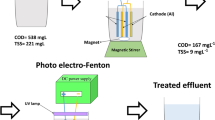Abstract
A comprehensive laboratory experimental study was conducted on the application of electroflotation in removal of paint from automotive paint system. In 40 min testing time and under 44 A/m2 current density, the total suspended solids (TSS) removal rates ranged from 90.39 to 97.43%. The first and second-order rate constants were developed. The kinetics of the TSS removal from the automotive paint wastewater was best described with the second-order rate constants. Two statistical methods were applied to identify the key factors for electroflotation performance among the Initial TSS Concentration, Current Density, water pH, Zeta Potential and Electrical Conductivity. It was confirmed that in both methods, the Initial TSS Concentration and Current Density were the most significant variables. Further, through Response Surface Methodology and Stepwise Regression analysis, equations of the removal rate of TSS vs reaction time and applied current density were produced for different wastewater samples.



Similar content being viewed by others
References
Adjeroud N, Dahmoune F, Merzouk B, Leclerc JP, Madani K (2015) Improvement of electrocoagulation–electroflotation treatment of effluent by addition of Opuntia ficus indica pad juice. Sep Purif Technol 144:168–176
Ahmadian M, Yousefi N, Van Ginkel SW, Zare MR, Rahimi S, Fatehizadeh A (2012) Kinetic study of slaughterhouse wastewater treatment by electrocoagulation using Fe electrodes. Water Sci Technol 66(4):754–760
Alam R, Shang JQ (2017) Removal of bitumen from mature oil sands tailings slurries by electro-flotation. J Water Process Eng 15:116–123
APHA, AWWA, WEF (1999) Standard methods for the examination of water and wastewater. American Public Health Association, Washington DC, USA
Araya-Farias M, Mondor M, Lamarche F, Tajchakavit S, Makhlouf J (2008) Clarification of apple juice by electroflotation. Innovative Food Sci Emerg Technol 9(3):320–327
Baierle F, John DK, Souza MP, Bjerk TR, Moraes MS, Hoeltz M, Rohlfes AL, Camargo ME, Corbellini VA, Schneider RC (2015) Biomass from microalgae separation by electroflotation with iron and aluminum spiral electrodes. Chem Eng J 267:274–281
Bande RM, Prasad B, Mishra IM, Wasewar KL (2008) Oil field effluent water treatment for safe disposal by electroflotation. Chem Eng J 137(3):503–509
Berthouex PM, Brown LC (2002) Statistics for environmental engineers. Lewis Publishers/CRC Press, Boca Raton
Bhaskar Raju G, Khangaonkar PR (1984) Electroflotation-a critical review. Trans Indian Inst Metals 37(1):59–66
Essadki AH, Gourich B, Azzi M, Vial C, Delmas H (2010) Kinetic study of defluoridation of drinking water by electrocoagulation/electroflotation in a stirred tank reactor and in an external-loop airlift reactor. Chem Eng J 164(1):106–114
Geffen CA, Rothenberg S (2000) Suppliers and environmental innovation: the automotive paint process. Int J Oper Prod Manag 20(2):166–186
Jiménez C, Sáez C, Cañizares P, Rodrigo MA (2016) Optimization of a combined electrocoagulation-electroflotation reactor. Environ Sci Pollut Res 23(10):9700–9711
Kalyani KP, Balasubramanian N, Srinivasakannan C (2009) Decolorization and COD reduction of paper industrial effluent using electro-coagulation. Chem Eng J 151(1–3):97–104
Kobya M, Demirbas E, Bayramoglu M, Sensoy MT (2011) Optimization of electrocoagulation process for the treatment of metal cutting wastewaters with response surface methodology. Water Air Soil Pollut 215(1–4):399–410
Kyzas GZ, Matis KA (2016) Electroflotation process: a review. J Mol Liq 220:657–664
Matis KA (ed) (1994) Flotation science and engineering. CRC Press, Boca Raton
Murugananthan M, Raju GB, Prabhakar S (2004) Separation of pollutants from tannery effluents by electro flotation. Sep Purif Technol 40(1):69–75
Myers RH, Montgomery DC, Anderson-Cook CM (2009) Response surface methodology: process and product optimization using designed experiments. Wiley, Hoboken
Ni C, Xie G, Jin M, Peng Y, Xia W (2016) The difference in flotation kinetics of various size fractions of bituminous coal between rougher and cleaner flotation processes. Powder Technol 292:210–216
Nonato TCM, Schöntag JM, Burgardt T, Alves AADA, Broock WF, Dalsasso RL, Sens ML (2018) Combination of electroflotation process and down-flow granular filtration to treat wastewater contaminated with oil. Environ Technol 39(6):717–724
OICA (2017) Production statistics. International Organization of Motor Vehicle Manufacturers. http://www.oica.net/production-statistics. Accessed 9 April 2018
Papasavva S, Kia S, Claya J, Gunther R (2001) Characterization of automotive paints: an environmental impact analysis. Prog Org Coat 43(1–3):193–206
Qin X, Yang B, Gao F, Chen G (2012) Treatment of restaurant wastewater by pilot-scale electrocoagulation-electroflotation: optimization of operating conditions. J Environ Eng 139(7):1004–1016
Rawlings JO, Pantula SG, Dickey DA (2001) Applied regression analysis: a research tool. Springer, New York
Salihoglu G, Salihoglu NK (2016) A review on paint sludge from automotive industries: generation, characteristics and management. J Environ Manag 169:223–235
Sridhar R, Sivakumar V, Immanuel VP, Maran JP (2012) Development of model for treatment of pulp and paper industry bleaching effluent using response surface methodology. Environ Prog Sustain Energy 31(4):558–565
Zhang H, Liu J, Cao Y, Wang Y (2013) Effects of particle size on lignite reverse flotation kinetics in the presence of sodium chloride. Powder Technol 246:658–663
Zhao S, Huang G, Cheng G, Wang Y, Fu H (2014) Hardness, COD and turbidity removals from produced water by electrocoagulation pretreatment prior to reverse osmosis membranes. Desalination 344:454–462
Zhou J, Chen D, Jiang Y, Yang K, Wang H, Zhou J (2016) Removal of color caused by dissolved organic matter from groundwater by electroflotation-filtration continuous flow reactor and optimization by response surface methodology. Desalin Water Treat 57(2):754–764
Zorpas AA, Inglezakis VJ (2012) Automotive industry challenges in meeting EU 2015 environmental standard. Technol Soc 34(1):55–83
Acknowledgments
This study was supported by the University of Western Ontario and the National Science and Engineering Research Council of Canada (NSERC). The experimental program was partially funded by Daimler Chrysler Co.
Author information
Authors and Affiliations
Corresponding author
Rights and permissions
About this article
Cite this article
Mohtashami, R., Shang, J.Q. & Xu, Y. Treatment of Automotive Paint Wastewater Using Electroflotation: Kinetic Study, Influencing Factors and Data Analysis. Environ. Process. 5, 577–591 (2018). https://doi.org/10.1007/s40710-018-0324-5
Received:
Accepted:
Published:
Issue Date:
DOI: https://doi.org/10.1007/s40710-018-0324-5




